Hi all,
I saw my Moorish idol with cloudy eyes last week and after some close inspection saw some clear flukes. Seemed to be on eyes, fins and lips which seems to narrow down the species. Had it asap in a 5min FW dip and well over a dozen flatworms came off the fish. That was a week ago and the fish is so much better now, even the eyes are clearer. It seemed to be a pretty heavy infestation. But given the lifecycle of the flatworms I know they will be back. Pics of the worms.. I only collected a few .. there were many more.
My question is about treatment. Given that they are actually flatworms. Will things like flatworm exit or flatworm RX work? I’ve read the threads here and humblefish’s threads and Prazipro seems to be the go to. But it’s very hard to get here but i have managed to get praziquantel 100mg tablets.
Treatment would be in main tank. Mixed reef but LPS dominated some sps . Only softies is some zoa frags. I want to make sure all fish are protected even though I’ve been told these flukes are very host specific. So.. prazi tabs or flatworm rx? Which is easiest on the corals given that my main target is the fish. Also taking the moorish out would be hard on it and risk reinfection when added back to the tank anyway.
Any help appreciated.

I saw my Moorish idol with cloudy eyes last week and after some close inspection saw some clear flukes. Seemed to be on eyes, fins and lips which seems to narrow down the species. Had it asap in a 5min FW dip and well over a dozen flatworms came off the fish. That was a week ago and the fish is so much better now, even the eyes are clearer. It seemed to be a pretty heavy infestation. But given the lifecycle of the flatworms I know they will be back. Pics of the worms.. I only collected a few .. there were many more.
My question is about treatment. Given that they are actually flatworms. Will things like flatworm exit or flatworm RX work? I’ve read the threads here and humblefish’s threads and Prazipro seems to be the go to. But it’s very hard to get here but i have managed to get praziquantel 100mg tablets.
Treatment would be in main tank. Mixed reef but LPS dominated some sps . Only softies is some zoa frags. I want to make sure all fish are protected even though I’ve been told these flukes are very host specific. So.. prazi tabs or flatworm rx? Which is easiest on the corals given that my main target is the fish. Also taking the moorish out would be hard on it and risk reinfection when added back to the tank anyway.
Any help appreciated.























